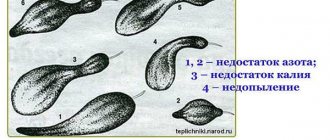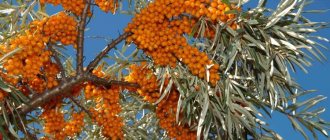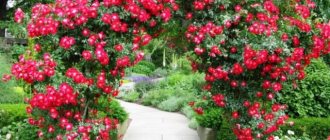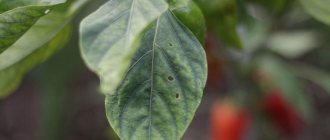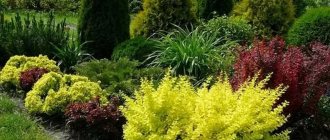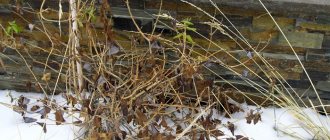Sea buckthorn fly
The most serious pest of sea buckthorn, in some years it can destroy up to 80 - 90% of the crop.
It overwinters in the pupal stage in the top layer of soil (at a depth of 5-10 cm) or under fallen leaves under female trees. The flight of flies from wintering areas begins in mid-June and ends in mid-July. After 1 - 2 weeks, the female begins to lay eggs under the skin of the berries - one egg in each. The hatching of larvae begins in the first half of July and is as extended as the emergence of flies. The larvae feed on the pulp of the berries. Damaged berries are easy to distinguish from healthy ones. A bright spot forms at the place where the female made a puncture with her ovipositor. Later, the berries darken, wrinkle, and a small white larva is found inside. Even later, the berries dry out and fall off. Having finished feeding, the larva goes into the soil, pupates and overwinters in this state.
Sea buckthorn diseases: symptoms and treatment
Sea buckthorn is affected by infections related to fungal diseases. The symptoms of such diseases are not hidden and are easily detected by visual examination. We will look at the most common infections below.
Endomycosis
Fungal disease of sea buckthorn fruits. Fruits that have mechanical damage are susceptible to infection. Endomycosis is spread by sea buckthorn aphids and copperheads. Endomycosis spores are not able to penetrate whole fruits.
The fruit's characteristics include a dull white color and a decrease in turgor, as a result of which juice flows out of sea buckthorn berries when harvested. The weight of the fruit decreases and the contents become slimy.
In the spring, spraying with 4% Bordeaux mixture or 3% Pitrafen solution helps reduce fungal damage by 2 times. After the ovaries appear, they are treated with 0.4% Cuprozan. In summer and autumn, treatments aimed at combating endomycosis are not effective.
Scab
The disease is caused by a fungus that attacks young shoots and sea buckthorn fruits. Leaf scab spreads quickly and is characterized by the following symptoms:
- tuberous formations on the leaves;
- shiny black spots;
- yellowness of leaves;
- mummified fruits.
In the first season, scab kills up to 50% of the crop. If no measures are taken, infected sea buckthorn bushes may dry out after wintering. To prevent this from happening, the plant is sprayed with 3% Nitrafen before the buds open. When preparing a plant for winter, first of all, branches affected by scab are cut off, then the fallen leaves are burned.
Brown spot
Another type of fungal disease that first affects the leaves, and then the bark and fruits of sea buckthorn. A sign of fungus are brown and brown spots that grow and merge with each other.
Subsequently, the upper part of the tissue dies and pycnidia form on it. Mushrooms are black, clearly visible dots. These are fruiting bodies that can be solitary, scattered over the surface or collected in groups.
In spring and autumn, the plant is sprayed with Bordeaux mixture at 1% concentration. Parts of sea buckthorn affected by the fungus are cut off and burned.
Stem rot
The causative agent of stem rot is a tinder fungus that settles in the bark of trees. The presence of the fungus leads to separation of the sea buckthorn trunk into thin annual plates. Therefore, stem rot is also called white ring rot.
Trunk rot occurs on sea buckthorn bushes if they have mechanical damage, cracks or other damage to the bark. In winter, the fungus remains inside the bark, so the affected parts of the plant need to be cut off. Bordeaux mixture and HOM help in the fight against fungus if you spray sea buckthorn before the buds open.
If you notice damage on the sea buckthorn bark, treat it with copper sulfate and paint over it with oil paint.
Ulcerative necrosis of the cortex
The causative agent of this disease is fungal spores that settle inside the bark of sea buckthorn trees and shrubs. Symptoms of ulcerative necrosis are convex growths on the branches of sea buckthorn. After the bark dies, necrosis cracks and a black, raised part of the wood becomes visible.
The fungal spores land on new areas of the bark, which gradually dries out, the branches die off, and the sea buckthorn dies. On young shoots affected by necrosis, more deep ulcers form.
To combat ulcerative necrosis, the same treatment is used as for stem rot. It is possible to disinfect foci of necrosis that appear on the sea buckthorn bark with a weak solution of copper sulfate.
Alternaria sea buckthorn bark
With humidity, dampness and dense plantings, a velvety black coating appears on the sea buckthorn. It is a sign of Alternaria bark blight - a fast-growing fungus that causes leaves to dry out and fall off, and branches to die.
In order to avoid Alternaria blight, plantings are thinned out, treated with Bordeaux mixture, infected branches are cut off and burned.
Nectria necrosis
A fungal disease that mainly affects young shoots of sea buckthorn. Nectria necrosis can be recognized by brick-red cushions. They are carriers of spores and are located longitudinally.
Drying of the bark leads to the death of the branch and the death of the sea buckthorn. Therefore, the growths must be cut off. When fighting nectria necrosis, spraying with 1% Bordeaux mixture helps a lot.
Septoria spot
It is the appearance of spots on the upper side of the leaves. The spots are round in shape and dark brown in color. After some time, the leaf tissue with the presence of stains cracks and falls out. This is fraught with the following consequences:
- decreased frost resistance;
- lack of growth of young shoots;
- leaves falling off ahead of schedule.
Septoria spotting is treated in the same way as brown spotting.
Fusarium wilt
The disease is infectious in nature. Symptoms appear in midsummer when some of the sea buckthorn leaves begin to turn yellow and suddenly fall off. Sea buckthorn berries turn orange prematurely and wilt. After wintering, the trees do not recover and die.
Blackened wood and swollen bark may be found at the base of the sea buckthorn tree. A pinkish coating appears on fruits that have survived the winter.
Fusarium wilt is practically untreatable and leads to the death of 10-20% of plantings.
Blackleg
Often, fungi living in the soil infect seedlings, which leads to blackening of the sea buckthorn stem and its death. To prevent this disease, a substrate is prepared for the plant, consisting of equal parts of turf soil and sand. After planting, the seedlings are disinfected with a weak solution of potassium permanganate.
Heterosporiasis
A fungal disease most often affects sea buckthorn leaves. It is expressed in the appearance of spots on them with a light purple border, which are found on the back of the sheet. The spots merge over time and cause the leaf to die. Spots on the bark of sea buckthorn are carriers of heterosporiosis.
The disease is not capable of causing significant damage to the crop. To get rid of it, the plant is cleaned of infected leaves.
Verticillium wilt
The fungus attacks mature trees over 5 years old, depriving them of nutrients and moisture. Symptoms of vertillus wilt include:
- sudden yellowing and falling of leaves;
- wrinkling and loss of turgor of berries;
- slow growth;
- root rot;
- drying of branches.
If the fungus is detected in time, the sea buckthorn can be saved by cutting off the dried branches. Otherwise, the disease cannot be treated; infected bushes are dug up and burned.
Black cancer
Another fungal disease, the symptoms of which are expressed in the appearance of black spots on the bark of sea buckthorn trees. After some time, the bark scatters, exposing black wood. Ulcers form at the site of merged spots, and sea buckthorn stops growing.
Black cancer can be defeated if you clean the affected area. Then the stripped trunk should be treated with a mixture of mullein, clay and copper sulfate.
Fruit rot
Sea buckthorn berries are affected by a fungus, which has a detrimental effect on the harvest. Lightened fruits cease to be elastic, and spore carriers appear on their surface - white cushions. Afterwards, the berries turn black and mummify.
The remaining mummified sea buckthorn fruits become carriers of infection. Therefore, it is necessary to thoroughly clean the diseased tree from blackened berries and spray it with a Bordeaux mixture of 1% concentration.
Green sea buckthorn aphid
Appears in large numbers in some years. The eggs overwinter on the tops of branches near the buds. During bud break, larvae hatch. They suck juices from young leaves and later move to the underside of the leaf. Over the summer, the aphid produces several generations, and already in the first half of summer the leaf is densely populated with aphids. Damaged leaves curl, turn yellow and crumble, shoots bend and stop growing, berries become dry and tasteless. Plants may go into winter unprepared, which negatively affects their winter hardiness.
Measures to protect sea buckthorn from pests
To protect sea buckthorn from pests, you should follow the agricultural practices for growing this crop, thin out dense plantings, remove fallen leaves, and carry out preventive spraying twice a year.
Do not forget that sea buckthorn is a light-loving plant; remove dried branches and leaves so that excess moisture does not accumulate at the roots. It is recommended to strengthen the soil with sand or peat.
Old varieties of sea buckthorn are mainly susceptible to diseases. Therefore, for planting, choose recently bred shrubs that are less susceptible to infections. Carry out constant monitoring of plants for the presence of parasites; it will allow you to identify pests in time, and proper treatment will save your garden.
0
0
Copy link
Sea buckthorn endomycosis
A disease of fungal origin. It is focal in nature. The disease begins to appear in early August. The affected berries become soft, flabby, their shell becomes discolored and filled with grayish mucus, which does not have the characteristic smell of sea buckthorn. After two weeks, the shell of the diseased berry easily ruptures and its contents flow out. Berries become infected upon contact with sick people. The spread of the disease is facilitated by rain and dew. Some sucking insects also carry the infection. The fungus overwinters on the inner skin of the burst berry, on the bark, and with the onset of warm weather, the spores infect the berries of the new harvest.
Factors influencing susceptibility to disease
There are many explanations why sooner or later gardeners encounter diseases of fruit trees and shrubs. Many of them can be prevented by taking timely preventive measures. Some diseases occur unexpectedly and for no apparent reason.
Let's highlight the main factors why sea buckthorn can get sick:
- planting varieties unadapted to given climatic conditions;
- growing a tree on unsuitable soils with close groundwater;
- frequent changes of frost and thaw;
- lack of nutrients;
- insufficient watering during long dry periods.
All of the above factors reduce winter hardiness, weaken the immune system, promote damping off of the bark in the root collar area, and become a favorable environment for the settlement of fungi and microorganisms.
Common pests and their control
The following pests cause irreparable harm to sea buckthorn:
- moth;
- gall mite;
- aphid;
- mole;
- sorrel bug;
- leaf roller.
Annual spring treatment with insecticides will help protect the garden from the above pests and maintain the productivity of sea buckthorn.
Moth
The moth is very dangerous for sea buckthorn. It settles on a tree in early spring and continues to cause damage until autumn. As a result of such coexistence, sea buckthorn loses all its foliage and remains completely bare.
When these annoying insects become widespread, insecticides are used.
Gall mite
The appearance of gall mites on sea buckthorn can be easily recognized by specific swellings of the leaves. Damaging the buds and causing premature loss of leaves, this dangerous insect often causes the death of the tree.
See also
When and how to prune barberry correctly for beginners
Read
Sea buckthorn aphid
When settling on sea buckthorn, aphids feed on the cell sap of the leaves, causing them to curl and die. As a result of damage, flowering and fruit development are suspended.
If no action is taken in time, disruption of photosynthesis causes branches to dry out and the tree to die. Abundant spraying with a solution of laundry soap is an effective measure in the fight against sea buckthorn aphids.
Sea buckthorn fly
With the arrival of summer and the ripening of fruits, sea buckthorn fly larvae overwintering in cocoons move to the berries and energetically eat them. Thus, seemingly harmless white worms cause irreparable harm to the crop. A layer of mulch of at least 15 centimeters in the tree trunk area will help prevent the appearance of white larvae on sea buckthorn. A dense layer prevents the larvae from emerging and protects the berries.
Mole
When settling in a garden plot, the moth actively lays eggs. In the summer, caterpillars emerge from them, feed on young leaves and buds, and strangle the plant with their tight web.
When moths are detected, treatment is carried out with Inta-Vir and its analogues. In advanced cases, spraying is carried out several times.
Sorrel bug
The sorrel bug is especially dangerous to the health of sea buckthorn. It feeds on the juice of young shoots, buds, leaves and causes serious damage to the tree. The yield of sea buckthorn decreases noticeably and its winter hardiness decreases.
To combat this insect, the plant is treated with Fufanon, Kemifos, and Kinmiks.
Plump leaf roller omnivore
The plump leaf roller is very fond of the leaves, fruits and flowers of sea buckthorn. It is very easy to detect - damaged foliage on a tree curls up into a tube. To combat the leaf roller, the tree is sprayed with a solution containing the insecticide Kemifos or Actellik.
Prevention measures
In order not to be surprised why the plant does not bear fruit or there are no berries on it, and also in order to reduce the risk of diseases and pests, you should adhere to several preventive measures.
- Initially, you should choose varieties that are resistant to pests.
- Always check planting material for damage or signs of disease.
- Check the area regularly and thoroughly for pests.
- Constantly remove weeds and plant debris.
- Feed the plant regularly.
- In early spring and autumn, spray the bushes with a 1% solution of Bordeaux mixture.
Scab or stegmina
Photo No. 3. Dried sea buckthorn plant due to scab damage
The disease is found everywhere and leads to drying out of the shoots, and with strong development - of the entire plant. Leaves, fruits and young shoots are affected. In mid-June - early July, especially in humid and hot summers, round black shiny spots with clear edges appear on the fruits. They increase until the end of August. Then pinkish or yellow slimy piles of spores appear, emerging through breaks in the skin of the fruit. Most of the fruits turn black and dry out. Males are also affected. Simultaneously with the damage to the fruit, black swellings of the bark form on the shoots of the current year, and on the leaves there are black velvety spots of irregular shape and sores located along the veins. The leaves curl at the ends and turn brown. Black swellings are noticeable on the annual shoots of the bush. A brown coating of sporulation forms on the shoots over the swellings. The bush seems to be splattered with black ink. Scab destroys up to 50% of the crop. The disease is spread by a huge number of conidia. They are carried by moisture droplets and, presumably, by insects and birds. The fungus persists in winter in the affected plant organs, on fallen leaves and fruits in the form of mycelium and conidia.
Control measures. To protect against scab, autumn pruning and burning of affected branches and leaves is recommended, as well as spraying with 1% Bordeaux mixture no later than 20 days before harvesting the fruits.
Shrub diseases: 9 common diseases
| cdn01.ru ” src=”https://qlumba.com/wp-content/uploads/2019/10/fmg5db7e672c84c19.jpg” alt=”table_pic_” w /> | Verticillium disease |
Can't understand why the leaves on the plant turn yellow? The reason for this may be verticillium disease - a serious disease that can completely destroy a bush in 2 years. Symptoms:
- the plant does not bloom, fades;
- the presence of dry shoots with signs of decay;
- poor bush development;
- leaves turn yellow and necrosis appears.
Way of fighting. Until now, no effective method has been found to combat Verticillium wilt. The only solution is to burn affected plants
Yellowtail
Black caterpillars with a carmine-red stripe along the back, a lateral red stripe, red warts and spots on the body appear when the leaves bloom and destroy them. Pupation occurs in the second half of June in dirty gray cocoons attached to the branches. In early July, butterflies emerge from the pupae and lay eggs mainly on the underside of the leaves in the form of elongated ridges, covered on top with hairs from the female’s abdomen. Caterpillars hatching from eggs (in the second half of July) feed on leaves until autumn and remain to overwinter (in the third instar). The yellowtail causes damage in some years in small outbreaks in sea buckthorn plantings.
Control measures. Spraying plantings with insecticides during the feeding period of younger caterpillars.
Post navigation
Not all gardeners who grow the beautiful fruits of this shrub in their summer cottage know about diseases and pests of sea buckthorn (unlike the scourges of gooseberries, apricots and others). But this crop has its own pathogens, leading to crop failure and even drying out of the bushes. Sea buckthorn is too valuable a berry crop to give it up without a fight. The fight against fungal diseases and insect pests will completely preserve the useful harvest of sea buckthorn and ensure the longevity of the plants. Among the diseases, endomycosis is the most destructive for fruits; among pests, the sea buckthorn fly is the most destructive. Other harmful organisms can also be dangerous to the plant.
